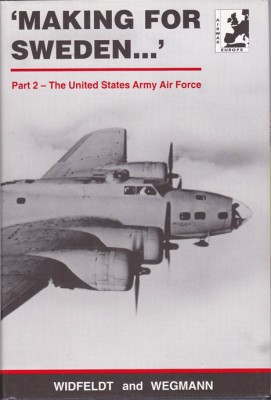10 Aug Making for Sweden
(1998) From the very beginning of this project, I kept hearing about a book that would be essential to my research: Making for Sweden, Part 2.
Authors Bo Widfeldt and Rolph Wegmann wrote two books in the late 1990’s. Part 1 is about the RAF airmen, and Part 2 documents the USAAF airmen who flew into Sweden for emergency landings when their aircraft could not make it back to England.
During World War II, Sweden declared their country to be strictly neutral. As such, Sweden cooperated with both the German and the Allies. Sweden’s neighboring countries, Denmark and Norway, were both occupied by the Nazi’s so I am sure that Sweden was doing everything in its power not to be.
As the Allies starting flying deeper and deeper into Germany, injured heavy bombers and fighter planes often found that they could fly safely into neutral Sweden when they did not have the ability to return to their English bases.
The first US aircraft, “Georgia Rebel” landed there in July of 1943. Another 199 would follow before the end of World War II.
In the beginning of the war, Sweden declared that all aircraft and personnel that landed there would be kept (“interned”) until the end of the war. As time went on, negotiations among Sweden, Germany, and the Allies caused them to release internees on an equal basis. Four Germans, Four Allies. This exchange policy continued with many variations until the end of the war.
When the Liberty Lady landed in Sweden in March of 1944, they flew there blindly, with no maps of the area to guide them. I recently watched an 8th Air Force training film from later in 1944, and the officer who was briefing the crews about their mission mentioned that they would be given a map of Sweden in case their planes could not make it back to base. Sweden would be a possible refuge for them.
This book is an excellent resource for anyone who is searching for information about the airmen who landed in Sweden. On March 6, 1944, in addition to the Liberty Lady there were three other planes that landed there. Barrick’s Bag lost two engines and after flying NE was met by Swedish fighter planes and led to safety. Hello Natural was losing fuel and made it to a Swedish airbase. A Good Ship & Happy Ship was able to make it to another airbase.
Liberty Lady is Case 63 as detailed on page 37. One fact that was new to me until I read it in this book is that the name Memphis Belle was also painted on its fuselage.
In all, the authors report that 1429 US crew members are registered to have either landed in Sweden … or escaped to Sweden after landing in Norway or Denmark. Even ten years ago they lamented that the numbers of these airmen are dramatically dwindling.
That’s why this book is so important to this portion of World War II history when our young crews and their crippled aircraft were able to find a safe haven in the country of Sweden.
Making for Sweden: Part 2 – The United States Army Air Force by Bo Widfeldt and Rolph Wegmann. Air Research Publications, Surrey.



moises ramirez
Posted at 16:30h, 03 MayAloha Pat!
Looks like ill be back in Sweden next week. Ill be heading to Vannacka and Loka Brunn this time. Ive found the location where the “Gerogia Rebel” crash landed almost 75 years ago this July and finally getting to see the “heaven on earth” that the internees found in the resort/spa of Loka Brunn. Let me know if you need any particular photos of either one. I will message you once im there and feel free to email me or message me through Instagram, Ill tag you on what I find…
Moi-